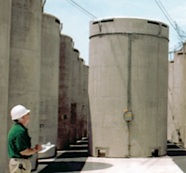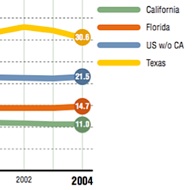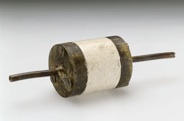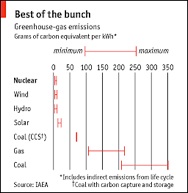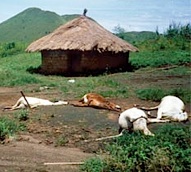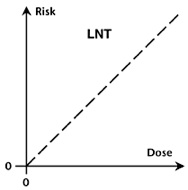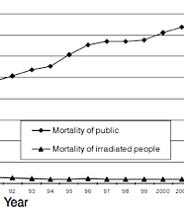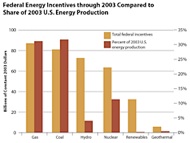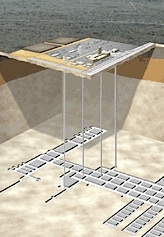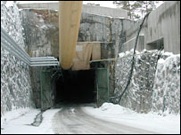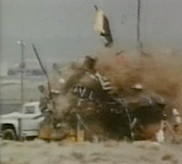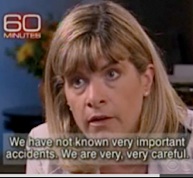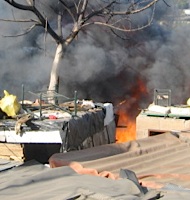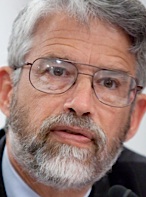I heard the remark voiced by David Whitford, Fortune editor-at-large, at a ”Fortune Brainstorm Green“ conference in 2008.
“Dear Michelle and Barack,” James Hansen, Dec. 29, 2008

Choosing a Way Forward: The Future Management of Canada’s Used Nuclear Fuel: Final Study (2005). NWMO. p 76
Choosing a Way Forward. p 159
Gwyneth Cravens (2007), Power to Save the World. Vintage. p 7
Gwyneth Cravens (2007), Power to Save the World. Vintage. p 7
UPDATE: According to space expert and solar expert Elon Musk, there is no hope for space solar. (He is head of SpaceX and SolarCity.) He tells me that even if access to orbit were free, the inefficiencies of energy collection and transmission rule it out as a viable source of baseload power on the ground.
“Stabilization Wedges: Solving the Climate Problem for the Next 50 Years with Current Technologies,” Stephen Pacala, Robert Socolow. Science, Aug. 13, 2004. pp 968-72
AllianceBernstein (Jan. 2008), Abating Climate Change. pp 66-67
AllianceBerstein (Jan. 2008), Abating Climate Change. p 51
“The Return of Killer Coal,” Fred Pearce. New Scientist, Mar. 12, 2008
Abating Climate Change. p 62 NOTE: “increased” in this sentence should be “decreased.”
UPDATE: As of July 2009, said a state press release, “all ocean-going vessels within 24 nautical miles of California's coastline must use cleaner burning diesel fuel in order to comply with a new state regulation aimed at reducing the emissions of oxides of sulfur and nitrogen and diesel particulate matter, a known carcinogen.” The regulation “will annually affect nearly 2,000 ocean-going vessels, both U.S. flagged and foreign-flagged, visiting California”
Lovelock — the inventor of the electron-capture detector — illustrated its superior sensitivity by the following metaphor: If one would pour about one liter of a perfluorocarbon liquid onto a blanket in Japan, and left it out to dry in the air by itself, a few weeks later one could detect on the west coast of England the vapor that had evaporated into the air in Japan from that blanket and carried by the jet stream around the world.
“Nuclear Power is the Only Green Solution,” James Lovelock. The Independent, May 24, 2004.

“Renewable and Nuclear Heresies,” Jesse Ausubel. Int. J. Nuclear Governance, Economy and Ecology, Vol. 1, No. 3, 2007. pp 229-243
“Why the Planet Needs Nuclear Energy,” Hugh Montefiore. The Tablet, Oct. 23, 2004.
“Let’s Talk About Nuclear Power and Other Energy Sources,” Tim Flannery. The Age, May 30, 2006.
“Tim Flannery Awarded Australian of the Year.” News in Science, Jan. 26, 2007.
“Atomic Balm?,” Jon Gertner. New York Times Magazine, July 16, 2006.
James Howard Kunstler (2004). The Long Emergency. p 146
“Greenhouse Gas Emissions of Electricity Generation Chains: Assessing the Difference,” Joseph Spadaro, Lucille Langloise, Bruce Hamilton. IAEA Bulletin, Vol. 42, Issue 2, 2000
For more on Art Rosenfeld and what is called the “Rosenfeld effect,” see the extensive Science article, “Leaping the Efficiency Gap,” (August 2009) here.
Yucca Mt UPDATE. In February 2009 the Obama administration reduced the Dept. of Energy’s budget for Yucca to near zero, effectively shutting down further development of the project.
An excellent technical discussion of Yucca Mt. and waste repositories in general is here.
Gore’s usual statement goes: “While I am not opposed to nuclear power and expect to see some modest increased use of nuclear reactors, I doubt that they will play a significant role in most countries as a new source of electricity.” That was in his 2006 talk at the New York University Law School, viewable here.
“Atomic Idyll,” Bill McKibben. OnEarth, Fall 2007
Gwyneth Cravens (2007), Power to Save the World. Vintage. p 112
“The Fission Division: Will Nuclear Power Split the Green Movement?,” Jason Mark. Earth Island Journal, Autumn 2007
“Nuclear Power? Yes Please,” Steve Connor. The Independent, Feb. 23, 2009 [This is a correction: in the book I mis-cited the quote to the Guardian.]
“Let’s talk about nuclear power and other energy sources,” Tim Flannery. The Age, May 30, 2006
“Five Qs&As with Bill McKibben,” Meteor Blades. European Tribune, Aug. 30, 2006
“10 Ways We Get the Odds Wrong,” Maia Szalavitz. Psychology Today, Jan./Feb., 2008
“Is Atomic Radiation as Dangerous as We Thought?,” Matthias Schulz. Spiegel, Nov. 23, 2007 Detailed data here.
On re-examination, that number of 250,000 for abortions looks too high and specific. One of my sources referred to the World Health Organization as the source of the number, but I couldn’t find it in any WHO documents. Another source claimed the International Atomic Energy Agency said the number was 100,000, but I couldn’t find confirmation in AIEA documents. Yet another source said 50,000. In future printings of the book I’ll limit my terminology to “thousands of abortions,” which does accord with the statements of WHO and other organizations.
“Scientist Puts Ultimate Chernobyl Death Toll at 500,000,” Kristina Lingren. Los Angeles Times, Sep. 10, 1986. Note: “Goffman” should be “Gofman.”
Chernobyl’s Legacy: Health, Environmental and Socio-Economic Impacts (2d revised version, 2006). Forum participants: IAEA, WHO, UNDP, FAO, UNEP, UN-OCHA, UNSCEAR, World Bank Group.
The estimate of 4,000 cancer deaths from Chernobyl may be too high. It is based on the increasingly controversial “linear no-threshhold” theory of radiation damage, discussed below on page 96.
Mary Mycio (2005). Wormwood Forest. Joseph Henry. p 3
A formal version of this prediction appears online here, where it can be discussed and voted on.
“Nuclear Power is the Only Green Solution,” James Lovelock. The Independent, May 24, 2004
Haseltine made this remark in a 2008 interview with GBN researchers about the future of biotech.
Chernobyl radiation may affect insects, however, according to a study published in 2008: “Reduced abundance of insects and spiders linked to radiation at Chernobyl 20 years after the accident.”
Joseph Romm (2005). The Hype About Hydrogen. Island Press. pp 101, 105, 107
UPDATE: The Ultra--Low-Level Radiation study is now under way. Details here.
This number comes at the conclusion of T.D. Luckey, The Health Effects of Low-Dose Ionizing Radiation. (Journal of American Physicians and Surgeons) Vol. 13 No. 2 Summer 2008. He writes: “The optimum level for chronic irradiation appears to be about 60 mSv/y, 30 times our average exposure.” [60 millisievert = 6,000 millirem/year.]
“Nuclear is Uneconomical” Amory Lovins. Mothers Alert, April, 2007
“Comment on Lovins article “Mighty Mice” by Ian Hore-Lacy, Director of public communications, World Nuclear Association, London in Nuclear Engineering International, Dec. 21, 2005
“Mighty Mice” Amory Lovins. Nuclear Engineering International, Dec., 2005. p 47
“An Interview with Amory Lovins”, Tyler Hamilton. Toronto Star, 2006
Video: Living With Chernobyl (2007) Cliff Orloff and Olga Shalygin
“For Russian Builder of Nuclear Plants, Business is Booming”, Andrew Kramer. New York Times, June 2, 2007
“Nuclear Power for India is Good For Us All”, David Victor. International Herald Tribune, Mar. 17, 2006
“The Nuclear Illusion”, Amory Lovins and Imran Sheikh. Ambio, 2009
“Energy Alternatives: Electricity Without Carbon”. Nature, Aug. 13, 2008
“Sweden Turns to a Promising Power Source, With Flaws”, Mark Landler. New York Times, Nov. 23, 2007
High Country News, Oct. 1, 2007. p 3
“Can Coal Live Up to Its Clean Promise?”, Fred Pearce. New Scientist, Mar. 27, 2008
“Carbon Dioxide Capture and Storage: Grasping at Straws in the Climate Debate?” New Scientist, Mar. 27, 2008
“Green Nuclear Power Coming to Norway,” Liz Williams. Cosmos Online, May 24, 2007
“Cleaner Nuclear Power?,” Peter Fairley. Technology Review, Nov. 27, 2007
“Stopping Coal in Its Tracks,” Ted Nace. Orion, Jan.-Feb, 2008
The quote is my recollection of a remark I heard Kahn repeat in several talks.
“A Conversation with Energy Guru Amory Lovins,” David Roberts. Grist, July 26, 2007
Gwyneth Cravens (2007), Power to Save the World. Vintage. p 339
“Greens for Nukes,” James Lovelock. Playboy, July, 2007. p 43
“Finland Buries Its Nuclear Past,” Richard Black. BBC News, Apr. 27, 2006.
“Nuclear Wasteland,” Peter Fairley. IEEE Spectrum, Feb., 2007
“An interview with accidental movie star Al Gore,” Al Revere. Grist, May 9, 2006
Email from Freeman Dyson, June 3, 2008
President Obama said in Prague: “We should build a new framework for civil nuclear cooperation, including an international fuel bank, so that countries can access peaceful power without increasing the risks of proliferation.… We must harness the power of nuclear energy on behalf of our efforts to combat climate change, and to advance peace opportunity for all people.“
“Meltdown,” Wyl S. Hylton. Gentleman’s Quarterly, March, 2008
“A Dark Shadow Behind Nuclear Power,” Camilla Cavendish. The Times, Jan. 10, 2008
“Vive les Nukes!,” 60 Minutes, Sep. 19, 2007. (Good survey comparing French and U.S. nuclear energy programs.)
“Nuclear Power.” Economist, Sep. 6, 2007
“Dear Michelle and Barack,” James Hansen, Dec. 29, 2008
Email from Freeman Dyson, June 3, 2008
“Nuclear Fission Power for 21st Century Needs,” Roderick Hyde, Muriel Ishikawa, Nathan Myhrvold, John Nuckolls, Lowell Wood. Progress in Nuclear Energy, March-Aug., 2008
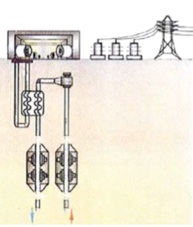
4.
New Nukes

Coal is the killer. Of all the fossil fuels, coal is the one that could make this planet uninhabitable.
—Fred Pearce, New Scientist
With climate change, those who know the most are the most frightened. With nuclear power, those who know the most are the least frightened.
—Variously attributed
For the definitive word on how much to worry about climate change, environmentalists in America have taken to relying on James Hansen, NASA’s authoritative and outspoken climatologist. When Hansen declared in 2007 that we must not settle for leveling off carbon dioxide in the atmosphere at 450 parts per million (ppm) but must take the level down from the current 387 ppm to 350 ppm or lower, the new environmentalist slogan became “350!”
Environmentalists take no notice of Hansen’s views on nuclear, however. As President Obama was taking office, Hansen wrote him an open letter suggesting new policy to deal with the climate crisis. “Coal plants are factories of death,” he wrote. “Coal is responsible for as much atmospheric carbon dioxide as the other fossil fuels combined.” Hansen proposed what America needed: a carbon tax “across all fossil fuels at their source”; the phasing out of all coal-fired plants; and “urgent R&D on 4th-generation nuclear power, with international cooperation.…”

It was a visit to Yucca Mountain, of all things, that began to change my mind about nuclear power. I’ll report the occasion in some detail because it’s a look inside a “here-be-dragons” blank area on most people’s mental map of the nuclear world, and you’ll watch two people reverse their opinion about nuclear and an organization change its mind about itself.…

The Yucca trip set in motion another board member’s conversion from anti- to pro-nuclear. Peter Schwartz, an energy expert who served for a long time on the board of Amory Lovins’s Rocky Mountain Institute, eventually became highly vocal on behalf of a nuclear revival. He and Lovins had friendship-threatening arguments on the subject.
_________
A year after the Yucca trip, Global Business Network was invited to run a scenario workshop for Canada’s Nuclear Waste Management Organization, which was conducting a series of meetings to explore what Canada should do with the waste from its twenty-two CANDU nuclear reactors.…


Sensing a story, she traveled with Anderson as her guide through the U.S. nuclear power industry and came up with a masterly account of the journey, Power to Save the World: The Truth About Nuclear Energy, published in 2007.…

(Space-based solar, however, could feed directly into baseload, microwaving the juice from orbit down to surface rectennas. Sunlight in space has three times the intensity of the pallid stuff on Earth, and it’s always on, so solar panels in space have three times the sun exposure of solar panels on roofs. That adds up to a ninefold advantage. Expensive commute, though. Japan is planning a 1-gigawatt space solar facility nevertheless, and a California utility claims it will have a 200-megawatt solar farm in orbit by 2016.)
_________
As for footprint, Gwyneth Cravens points out that “A nuclear plant producing 1,000 megawatts takes up a third of a square mile. A wind farm would have to cover over 200 square miles to obtain the same result, and a solar array over 50 square miles.” That’s just the landscape footprint. (By the way, 1,000 megawatts equals 1 gigawatt—a billion watts; I’ll use that measure most of the time here.)
More interesting to me is the hazard comparison between coal waste and nuclear waste. Nuclear waste is minuscule in size—one Coke can’s worth per person-lifetime of electricity if it was all nuclear, Rip Anderson likes to point out. Coal waste is massive—68 tons of solid stuff and 77 tons of carbon dioxide per person-lifetime of strictly coal electricity. The nuclear waste goes into dry cask storage, where it is kept in a small area, locally controlled and monitored. You always know exactly what it’s doing. A 1-gigawatt nuclear plant converts 20 tons of fuel a year into 20 tons of waste, which is so dense it fills just two dry-storage casks, each one a cylinder 18 feet high, 10 feet in diameter.
By contrast, a 1-gigawatt coal plant burns 3 million tons of fuel a year and produces 7 million tons of CO2, all of which immediately goes into everyone’s atmosphere, where no one can control it, and no one knows what it’s really up to. That’s not counting the fly ash and flue gases from coal—the world’s largest source of released radioactivity, full of heavy metals, including lead, arsenic, and most of the neurotoxic mercury that has so suffused the food chain that pregnant women are advised not to eat wild fish and shellfish. The air pollution from coal burning is estimated to cause 30,000 deaths a year from lung disease in the United States, and 350,000 a year in China.

As for comparing full-life-cycle, everything-counted greenhouse gas emissions, a study published in 2000 by the International Atomic Energy Agency shows total lifetime emissions per kilowatt-hour from nuclear about even with those of wind and hydro, about half of solar, a sixth of “clean” coal (if it ever comes), a tenth of natural gas, and one twenty-seventh of coal as it is burned today.
_________
Baseload. Footprint. Add portfolio—the idea that climate change is so serious a matter, we have to do everything simultaneously to head it off as much as we can. The first definitive portfolio statement came from engineer Robert Socolow and ecologist Stephen Pacala in 2004. Their paper in Science, “Stabilization Wedges: Solving the Climate Problem for the Next 50 Years with Current Technologies,” introduced the idea that a set of “stabilization wedges,” made up of already proven technologies and practices, could reduce greenhouse gas emissions to a tolerable level, but only if all the wedges are pursued extremely aggressively at the same time, starting yesterday.…

Al Gore’s climate movie, An Inconvenient Truth, featured Socolow’s diagram with only six wedges, leaving out nuclear.
_________
Of all the wedges, energy efficiency and conservation comes first, last, and always, as far as I’m concerned. You get the most result with the least cost at the greatest speed. As Amory Lovins has been proving eloquently for decades, saving energy doesn’t cost money; it makes money, and it can be carried out at every level, from individual behavior to global programs. Those who argued that conservation would do economic harm have been thoroughly refuted by events. Europeans and Californians use half the energy per person of most Americans, and they are doing fine. In the 1970s. the Jerry Brown administration in California set in motion an array of programs that kept energy use dead level for the next three decades while the state’s per capita income grew by 80 percent, and while the other states’ energy use went up by 50 percent. California’s greenhouse gas emissions per capita are less than half of what the other states put out.
How did California do that? A physicist named Arthur Rosenfeld at Lawrence Berkeley National Laboratory was inspired by the OPEC oil embargo of 1973 to shift his career to energy efficiency. Through his advocacy, California pursued “technology forcing” (specific mandates on efficiency in refrigerators and cars); new regulations on heat efficiency in buildings; tax credits for solar panels; and a decoupling of profits from sales in energy companies, so corporations like Pacific Gas & Electric were suddenly motivated to reward energy conservation in their customers and not motivated to build new power plants. My gang was in the thick of that. While I served on the governor’s personal staff, one Whole Earth friend (Huey Johnson) was Secretary of Resources, another (astronaut Rusty Schweickart) chaired the Energy Commission, two (Sim Van der Ryn and Peter Calthorpe) were running the State Architect’s office, and still another (Wilson Clark) ran the Office of Appropriate Technology.…

Brown set up a coalition of West Coast attorneys general, who will insist that the Clean Air Act applies to all shipping within the two-hundred-mile limit, so the ships will have to shift to cleaner fuel systems, such as diesel-electric, and scrub what comes out of their stacks if they want to do business on the West Coast.)
Efficiency improvement has already accomplished a lot. From 1975 to 2004, the world increased its “energy intensity” (the amount of energy consumed per dollar of GDP) by 32 percent (44 percent in the United States).…

Start with Jim Lovelock, Gaia’s prophet. Gaia theory itself is almost a Green religion, and Lovelock’s 1957 invention of the electron capture detector led first to the pesticide measurements behind Rachel Carson’s revolutionary Silent Spring (1962), then to the detection of environmental PCBs, then to the discovery of atmospheric chlorofluorocarbons and their role in ozone depletion. Lovelock has been pronuclear all his life, ever since his medical research with radioactive isotopes back in the 1940s. He promoted nuclear to my reluctant ears when I first met him in 1985. In a much quoted op-ed in England’s Independent in 2004, he wrote:
By all means, let us use the small input from renewables sensibly, but only one immediately available source does not cause global warming and that is nuclear energy. …

Jesse Ausubel, director of the Program for the Human Environment at Rockefeller University, convened a pioneering conference on climate change back in 1979. He originated the idea of decarbonization, noting the two-hundred-year trend of humans using fuels with ever fewer carbon atoms—wood to coal to oil to gas, down to zero carbon with hydrogen and nuclear. In 2007 he published a paper in the International Journal of Nuclear Governance, Economy and Ecology in which he declared, “Nuclear energy is green. Renewables are not green.”

Patrick Moore, a Canadian who got his PhD in ecology, was a cofounder of Greenpeace in 1971 and became its president in 1977. He left in 1986, declaring that the organization and the environmental movement had become antiscience. Still a strong proponent of forestation, he is best known as a Green spokesman for nuclear power, with a paid role these days as cochair of the Clean and Safe Energy Coalition, founded by the Nuclear Energy Institute, a U.S. lobbying organization.
_________
The late Anglican Bishop Hugh Montefiore had been a trustee of UK Friends of the Earth for twenty years when he became convinced by climate dangers that as an environmentalist he had to support nuclear power. Told that he could not stay on as a Friends of the Earth trustee if he did that, he resigned, and wrote in a 2004 article,
The future of the planet is more important than membership of Friends of the Earth. … The real reason why the Government has not taken up the nuclear option is because it lacks public acceptance, due to scare stories in the media and the stonewalling opposition of powerful environmental organisations. Most, if not all, of the objections do not stand up to objective assessment.

Tim Flannery is a world-renowned Australian biologist and conservationist who wrote what is considered one of the best books on climate, The Weather Makers (2006). In a 2006 column for a Melbourne newspaper, he posited that
Over the next two decades, Australians could use nuclear power to replace all our coal-fired power plants. We would then have a power infrastructure like that of France, and in doing so we would have done something great for the world, for whatever risks go with a domestic nuclear power industry are local, while greenhouse gas pollution is global in its impact.
The next year he amended his view to support nuclear in places like China, Europe, and the United States that don’t have Australia’s renewable energy resources. Australia should keep selling its abundant uranium to those markets, he declared, but should not build its own nuclear plants.
John Holdren, President Obama’s science adviser, is an energy and environment heavyweight. He has been an expert on nuclear weapons proliferation, professor of environmental policy at Harvard, director of Woods Hole Research Center, and long a coauthor with Paul Ehrlich of ecopolicy texts. His stature gave him cochairmanship of the National Commission on Energy Policy, and he wrote the commission’s authoritative 2004 report, Ending the Energy Stalemate. It recommended, among other things, that Congress expand support for developing a new generation of nuclear reactors, and it pushed for centralized “interim” storage sites for spent fuel—a detour around the Yucca Mountain roadblock. Holdren told a New York Times reporter, “I’m often asked, ‘Can you solve the climate problem without nuclear energy?’ And I say, ‘Yes, you can solve it without nuclear energy.’ But it will be easier to solve it with nuclear energy.”

Jared Diamond, biologist, conservationist, and author of Collapse (2004), had read Holdren’s report closely, so when he was asked by an audience member at a San Francisco talk if he “agreed with Stewart Brand in supporting the revival of nuclear,” he surprised the audience and me by saying yes: “To deal with our energy problems we need everything available to us, including nuclear power.”
James Howard Kunstler, fervent opponent of suburbs, wrote a book in 2004 titled The Long Emergency. I’m persuaded by neither his expectation of how peak oil plays out nor his views on the fragility of big cities, but many environmentalists are, and they should note that he ends his “Beyond Oil” chapter with the words, “Nuclear power may be all that stands between what we identify as civilization and its alternative.”
There is a category of prominent environmentalist that I predict will increase in coming years—the reluctant tolerators. When they express support of nuclear, they are careful to use sentences too complex to be quote-worthy. Al Gore is one such; he told a Congressional hearing what he usually avoids saying in public, that he is not opposed to nuclear power and expects it will grow somewhat. My old teacher Paul Ehrlich says that climate issues have made him more supportive of nuclear. Bill McKibben, author of The End of Nature, penned a friendly review of Gwyneth Cravens’s Power to Save the World in the environmentalist publication OnEarth. “Environmentalists need to understand that times and circumstances change,” he wrote, “and they need to rethink priorities.…”


For a fine piece of journalism about the nuclear debate within the environmental movement, Jason Mark, editor of Earth Island Journal, did his research online. As he reported in his 2007 article, “The Fission Division,”
The anti-nuclear consensus among environmental policy professionals…does not extend to the grassroots. A review of some of the most popular green news and opinion Web sites reveals a lively discussion about the merits of expanding nuclear power generation.…

In 2009 the Director of Greenpeace UK from 2001 to 2007, Stephen Tindale, told the Independent he was now supporting nuclear, and he wasn’t alone:
My change of mind wasn’t sudden, but gradual over the past four years. But the key moment when I thought that we needed to be extremely serious was when it was reported that the permafrost in Siberia was melting massively, giving up methane, which is a very serious problem for the world.
It was kind of like a religious conversion.…

In 2008 the world had 443 civilian nuclear reactors boiling up 16 percent of all electricity and keeping a yearly 3 gigatons of carbon dioxide that would have been generated by coal plants out of the atmosphere. Year after year, the industry has had no significant accidents, having learned hard lessons from the three that got away—England’s Windscale fire in 1957, the Three Mile Island meltdown in 1979, and the Chernobyl steam explosion in 1986.
“Because a single new accident could destroy the entire nuclear industry worldwide,” Tim Flannery argues, “lots of work has gone into minimizing the risk of accidents. As a result, new nuclear technology is relatively safe.” Bill McKibben makes a different point: “Nuclear power is a potential safety threat, if something goes wrong. Coal-fired power is guaranteed destruction, filling the atmosphere with planet-heating carbon when it operates the way it’s supposed to.”
McKibben’s pragmatism suggests we reassess our fears in light of real risks closely examined, and that begins with noticing how fear works. An article in Psychology Today, “Ten Ways We Get the Odds Wrong,” lists some of the elements that play out in nuclear dread:
We fear spectacular, unlikely events. …
We underestimate threats that creep up on us. …

Thus the chemical release of the Bhopal incident in 1984 is treated as far less consequential than the radiation release from Chernobyl, even though over six thousand died from Bhopal versus fifty-six from Chernobyl (forty-seven workers, nine children). Through fear of radiation and expected birth defects, the World Health Organization reported, couples in the Chernobyl area had 250,000 abortions. But no human birth defects have been found to result from Chernobyl—nor, by the way, from Hiroshima. As for disease, the low-dose-radiation expert John Gofman declared that “the number of fatal cancers to come over the years and decades ahead as a direct result of this accident will not be lower than 500,000.” In fact it was less than 1 percent of that figure.
“It is roughly estimated that the total number of deaths from cancers caused by Chernobyl may reach 4,000 among the 600,000 people having received the greatest exposures.” So says the Chernobyl Forum’s report, which was exhaustively researched by seven UN agencies and published in 2006. Its findings are summarized online at the ever-illuminating GreenFacts.org site. About 100,000 of the 600,000 most exposed would die of cancer in any case—if Chernobyl had never happened. For every 100 of the normal cancer victims, four may die earlier because of Chernobyl radiation. Statistically it is a nonevent—epidemiology can’t detect it.
The real damage to people in the region, according to the Chernobyl Forum report, is from poverty and mental stress. “The most significant public health impact of Chernobyl has been on mental health,” says Luisa Vinton, who headed the forum, in the video Living with Chernobyl (2007). “The conclusion we’ve come to is that fear of radiation is a far more important health threat than radiation itself.…”

In a fascinating book, Wormwood Forest: A Natural History of Chernobyl (2005), Mary Mycio observes that
It is one of the disaster’s paradoxes, but the zone’s evacuation put an end to industrialization, deforestation, cultivation, and other human intrusions, making it one of Ukraine’s environmentally cleanest regions—except for the radioactivity. But animals don’t have dosimeters.…

Robert Baker concludes on his home page that as far as the Chernobyl animals are concerned, “the elimination of human activities such as farming, ranching, hunting and logging are the greatest benefit, and it can be said that the world’s worst nuclear power plant disaster is not as destructive to wildlife populations as are normal human activities. Even where the levels of radiation are highest, wildlife abounds.…”

I predict there will be a Chernobyl National Park. It has the perfect ingredients. It is a major historic site. When 330,000 people moved out and wildlife moved in, it became one of Europe’s finest natural preserves.… Already reforested, the ghost town of Pripyat, which once housed 50,000, is a poignant reminder of the cost of design folly—the Chernobyl reactors had no containment structures.


The great Green hope, hydrogen, has reactivity that weakens pipes, volatility that makes it the most leak-prone of gases, and an ignition point so low that a cellphone can ignite it; and it burns with an invisible flame. Another Green hope, vast quantities of carbon dioxide to be captured at coal-fired plants and piped to underground sequestration, introduces yet another dangerous gas to the energy spectrum. In 1986 a dense cloud of CO2 belched out of Lake Nyos in Cameroon, flowed downhill at 20 miles an hour, and suffocated 1,700 villagers and 3,500 livestock up to fifteen miles away. Known all too well to miners as “choke damp,” carbon dioxide kills instantly in any concentration greater than 15 percent.…

I asked Jim Lovelock for his views on low-dose radiation: “The jury is still out, is my answer,” he said. “There are two schools. One school says low dosage is good for you. It’s called hormesis. There’s growing evidence for that; it looks quite interesting.…”



The Environmental Protection Agency relies on the no-threshold model to require that nuclear sites do whatever it takes to expose the nearby public to no more than 15 millirems of radiation a year. That is half a mammogram (30 mrem), a fifth of the range of normal U.S. background radiation (from 284 mrem in Connecticut to 364 mrem in Colorado), a sixty-sixth of a CT scan (1,000 mrem; 62 million are done every year in the United States), and an eightieth of one year of smoking a pack and a half of cigarettes a day (1,300 mrem; there are 45 million smokers in the United States). People in Ramsar, Iran, live with a background radiation of 13,000 millirems a year with no apparent health consequences. Astronauts are allowed 25,000 millirems per shuttle mission.…


The Lovins brief against nuclear (or what one opponent calls his “obsessive ongoing vendetta against nuclear”) makes the following case.…

By micropower Lovins means efficiency, cogeneration (also known as CHP—combined heat and power), small hydro, and renewables such as wind, solar, biomass, and geothermal. “The cheapest, most reliable power is typically produced at or near customers.” To Lovins, government intervention to assist nuclear because of climate fears is actually counterproductive because it tilts investment away from the micropower alternatives, which are faster and cheaper to deploy and more effective against climate change. “In no new nuclear project around the world is there a penny of private capital at risk.”
In 1986 a TV interviewer asked Lovins about the future of nuclear power. “There isn’t one,” he replied. “No more will be built. The only question is whether the plants already operating will continue to operate during their lifetime, or whether they’ll be shut down prematurely.” At a debate in 2007 he declared, “Nuclear is dying of an incurable attack of market forces despite what the industry wants you to believe.…”


Gordon Brown’s Labor government in England made the decision to upgrade all of its nineteen reactors and build new ones.

India, with seventeen reactors now providing 3 gigawatts of power, plans to expand the capacity tenfold to 30 gigawatts.
After ordering two reactors from Westinghouse, China signed a $12 billion deal with AREVA—said to be the largest in the history of the industry—and is aiming to grow its nuclear capacity to 70 gigawatts by 2020. It has eleven reactors working, five under construction, thirty planned, and eighty-six proposed.
Japan, the largest user of nuclear power after the United States and France, with fifty-five reactors in operation, is planning eleven new reactors by 2017. The government wants to transform its electricity mix from 30 percent nuclear now to 60 percent nuclear by 2050.
In early 2009, in Ambio magazine, Amory Lovins declared: “Nuclear power is continuing its decades-long collapse in the global marketplace because it’s grossly uncompetitive, unneeded, and obsolete.…”

It was market forces that gave us coal’s dominance—40 percent of the world’s electricity comes from coal (and 20 percent from gas, 16 percent from nuclear, 16 percent from hydro, 7 percent from oil, 2 percent from renewables).…

Wind is serious infrastructure, and growing fast—94 gigawatts capacity worldwide in 2007 (nuclear was 365 gigawatts; coal, 1,393 gigawatts). Expanding wind power always means expanding long distance power lines. In Denmark and Germany, which led the European wind revolution, new construction has tapered off due to rising costs and scarcity of appropriate sites.

_________
Solar so far is a bit player in electricity generation—10 gigawatts of capacity total in the world in 2007, but with solar’s 14 percent capacity factor, that’s only 1.4 gigawatts operational, less than one large nuclear reactor. I fondly remember the 1970s solar boom, which ended the moment Ronald Reagan became president and canceled Jimmy Carter’s solar tax credits. I had the delicious opportunity to interview Ted Turner in front of the 2007 Solar Power Conference, which had twice the attendance of the previous year, 12,500 people. Among them were only a few of the old solar guard such as John Schaeffer, whose solar mail-order catalog, Real Goods, has freed thousands from the grid since 1978. Schaeffer and I were surrounded by suits, most of them apparently avid to save the world and become rich from a technology they expected to be heavily subsidized any day. That’s why they wanted to hear from rich, Green, Ted Turner. Turner went cheerfully off topic to inveigh against the Iraq War, noting that the enemy motivated their troops by promising them forty virgins when they die. “If we had incentives like that for solar power,” Turner cracked, “we’d have it made.…”

With enough breakthroughs, sustained over decades, solar could and should become a leading source of electricity. Hasten that day! Meanwhile, the finance-management firm AllianceBernstein opines that “the solar industry has benefited recently from spectacular policy-driven growth.… We think that the speculative interest is becoming bubble-like, particularly given that industry fundamentals depend on government subsidies and political support.…”


(Details, with illuminating graphs, may be found in Robert H. Bezdek and Robert M. Wendling, “A Half Century of U.S. Federal Government Energy Incentives: Value, Distribution, and Policy Implications,” International Journal of Global Energy Issues, vol. 27, 2007, no. 1.) The study leaves out the copious subsidies at state level for renewable energy.
“Clean coal” is supposed to be a low-carbon alternative to nuclear for baseload power once we have carbon capture and sequestration (CSS). As of 2009, there was not a single demonstration plant using CSS, though China is working on one. Even industry proponents of CSS don’t expect the first commercial application before 2030 or broad use before 2050. The volume of CO2 that has to be dealt with is overwhelming. A 1-gigawatt coal-fired plant burns eighty rail cars of coal a day, each car carrying 100 tons of coal. The resulting CO2 weighs 2.4 times as much as the coal, so that plant will produce over 19,000 tons of carbon dioxide a day—7 million tons a year. It has to be separated, compressed to a liquid, piped to a suitable location, pumped down half a mile, and sealed off permanently. Good luck with that in the developing world. A Swede named Anders Hansson did the math on the billions of tons of carbon dioxide that would have to be buried to make a difference and concluded, “Carbon dioxide would be the world’s largest transported good.”

The rising price of uranium is driving new exploration, with finds turning up all over the world. The price rise also makes reprocessing of spent fuel more attractive, and that leverages existing uranium manyfold.

The leading substitute for uranium, thorium, is three times as abundant, and it can’t melt down, it’s useless for weapons, and it generates little waste.

“If you want to kill a power project,” advises one activist in Orion magazine, “focus on economics.” I recall the futurist Herman Kahn talking about the fight over the Trans-Alaska Pipeline in the 1970s: “The Greens began by complaining about the design of the pipeline, and they were right, it did have flaws. But once those were fixed, the Greens put all their effort into forcing delays and extravagances that raised the cost of the system.…”

But when Lovins aims his well-honed techniques at nuclear power, I think his private-sector bias gets in the way. He has said, “I admire those who try to reform public policy, but I don’t spend much time doing that myself. In a tripolar world of business, civil society, and government, why would you want to focus on the least effective of that triad?…”

WIPP, the Waste Isolation Pilot Plant in New Mexico, got through its safety reviews thanks largely to Rip Anderson, the scientist at Sandia Labs who guided Gwyneth Cravens through the nuclear world for her book. For political reasons, WIPP was assigned only waste (some low-level, some high-level) from U.S. military activities, while the high-level waste from the civilian energy program was supposed to go to Yucca Mountain in Nevada. Having studied every kind of repository in detail, Anderson declares:
From a technical point of view, the best place on dry land to store all nuclear waste—wherever it comes from—is at WIPP. We’ve proven that every way you can think of. We have traceability and transparency. Geologically and hydrologically, it’s the safest. There’s room for it, and more panels can be mined out of the salt bed whenever we want. It’s only politics and bureaucracy that stand in the way.

Jim Lovelock is baffled by the fuss:
Consider the Yucca Mountain nuclear-waste depository in Nevada: It cost a fortune to construct, and we need it about as much as we need a facility for imprisoning dangerous extraterrestrials.…

In Finland, construction is going ahead on a deep geological repository for high-level wastes at Eurajoki, where the project found a welcome because the local population had become comfortable with nuclear power: It has been generated in their neighborhood for thiry years. The repository should open for business in 2020. Meanwhile, Finland’s neighbor Russia wants to become a nuclear fuel handler for the world—mining, processing, shipping, and reprocessing fuel, and then storing the waste.
The method of dealing with nuclear waste in the United States that emerged, de facto, in the absence of a national repository is proving so practical that a new solution is based on it. U.S. reactor operators now put their spent fuel in pools to cool off for a few years, then pack it in dry cask storage out behind the parking lot. So it is for all 121 reactor sites in thirty-nine states. Since the casks are designed for transport (there’s a thrilling video made at Sandia of trains, planes, and trucks ramming the casks without release of spent fuel), the idea now being legislated—with the support of the Obama administration—is to cart them to a few well guarded “interim” sites where they can be parked for decades while the nation decides whether it wants to recycle the material or bury it.…

An article in the engineering magazine IEEE Spectrum on France’s exemplary reprocessing operation is what gives me some second thoughts. The facility at La Hague reprocesses 1,700 tons of spent fuel a year, with an impeccable safety record. But even in France, with its primary reliance on nuclear for electricity, the enormous cost of reprocessing makes it economic only if the price of uranium is very high, or if the nation is developing fast breeder reactors. While the eventual waste from reprocessed fuel is relatively short-lived, it is much “hotter” and trickier to handle than the once-through spent fuel.

And then there’s the weapons issue. That’s the one that keeps Al Gore hesitant about nuclear. He has said:
For eight years in the White House, every weapons-proliferation problem we dealt with was connected to a civilian reactor program. And if we ever got to the point where we wanted to use nuclear reactors to back out of a lot of coal—which is the real issue: coal—then we’d have to put them in so many places, we’d run that proliferation risk right off the reasonability scale.…

First, it should be said that nuclear energy has done more to eliminate existing nuclear weapons from the world than any other activity. Megatons to Megawatts (I guess they decided against Megadeaths to Megawatts) is the name of a joint US-Russia program to convert warheads into fuel. It began in 1994, and currently 10 percent of the electricity Americans use comes from Russian missiles and bombs. The goal is to convert twenty thousand nuclear warheads into fuel by 2013; that’s enough energy to run the whole U.S. nuclear fleet for two years.

This whole astonishing program has occurred with scant media attention and zero public hoopla. (Freeman Dyson tells me that’s good: “Important moves toward disarmament always go better when they are not reported in the media.…”)

The full argument against the nuclear terrorism threat is worth hearing from John Robb, who runs the brilliant blog Global Guerillas and wrote Brave New War (2007):
Though most of the worry over WMDs [weapons of mass destruction] has focused on nuclear weapons, those aren’t the real long-term problem. Not only is the vast manufacturing capability of a nation-state required to produce the basic nuclear materials, but those materials are difficult to manipulate, transport, and turn into weapons.…

That is the idea behind GNEP—the Global Nuclear Energy Partnership—which could wind up being the one lasting accomplishment of the George W. Bush administration.

Whether or not the GNEP prevails, it is just the most ambitious of several multinational fuel-cycle initiatives being proposed and funded. One or a combination of them is likely to be operative by the 2010s. President Obama announced his support of a nuclear fuel bank program before a global audience in Prague in early 2009.
_________
One reason the French were able to build a fleet of fifty-six reactors providing nearly all of the nation’s electricity in just twenty years was an efficient licensing process that took four years instead of the twelve years that became standard in the U.S. As a result, France has the cleanest air in Europe, the lowest electrical bills, and a $4 billion export business selling energy to all its neighbors, including Green Germany and nuclear Britain (2 gigawatts a year flows west under the English Channel). France shut down its last coal-fired plant in 2004. It emits 70 percent less carbon dioxide per capita than the U.S.…

Seeking that kind of acceleration, in 2005 Congress passed the Energy Policy Act with incentives for wind, solar, geothermal, biofuels, wave and tidal power, clean coal, efficiency and conservation… and nuclear. As the Economist summarized it, the act
offers four different types of subsidies for new reactors. First, it grants up to $2 billion in insurance against regulatory delays and lawsuits to the first six reactors to receive licences and start construction. Second, it extends an older law limiting a utility’s liability to $10 billion in the event of a nuclear accident. Third, it provides a tax credit of 1.8 cents per kilowatt hour for the first 6,000 megawatts generated by new plants. Fourth, and most importantly, it offers guarantees for an indeterminate amount of loans to fund new nuclear reactors and other types of power plant using “innovative” technology.…

(The reactors currently operating in the U.S. are generation II, and the ones now being constructed are referred to as generation III-plus—with better built-in safety and efficiency.) Generation IV designs, which are not expected to be commercial before the 2030s, aim for maximum all-round sustainability through lower construction and operating costs, super high fuel efficiency, greatly reduced waste with shorter-term radioactivity, and high temperatures capable of generating hydrogen or desalinating water. The goal is to solve permanently every one of the four major problems with current reactors—safety, cost, waste, and proliferation. A consortium of ten nations and the European Union is carrying out the research.
James Hansen suggests that the development of generation IV reactors could be sped up by applying some of the $28 billion already collected from the nuclear industry for waste storage: “This fund should be used to develop fast reactors that consume nuclear waste, and thorium reactors to prevent the creation of new long-lived nuclear waste.” The reactors he’s referring to are the integral fast reactor, which, he says, “can burn existing nuclear waste and surplus weapons-grade uranium and plutonium, making electrical power in the process,” and the liquid-fluoride thorium reactor. Full-scale working reactors, Hansen proposes, could be developed first in China, India, or South Korea, where the need is greatest, with American or European technical support. Deployed in the United States, the waste-burning reactors would make Yucca Mountain irrelevant.
Freeman Dyson comments: “Next-generation reactors could make a big difference. I like especially Lowell Wood’s scheme for building a thorium breeder that runs for fifty years without refueling. It is buried deep underground, and after the thorium is burned, it stays in the ground and is never touched.” Details on the design may be found in a 2008 paper in Progress in Nuclear Energy. The five authors conclude with the reactor’s advantages: “No more mining, no more enrichment operations, zero spent-fuel handling, no reprocessing or waste storage facilities, and the reactor vessel is the (robust) burial cask.…”

Right now Russia is building 35-megawatt reactors that float on barges, for use starting in 2010 along the nation’s newly navigable Arctic coast, and Russia’s developing-world clientele is expected to buy some for remote coastal villages. In Japan, Toshiba has invented a 10-to-50-megawatt “nuclear battery” the company calls 4S—for “super safe, small, and simple”—expected to be ready around 2015. Not to be outdone in the acronym department, the Lawrence Livermore Lab in California has a 20-megawatt reactor design it calls SSTAR—“small, sealed, transportable autonomous reactor.” The idea with these small units is that they can be trucked in and planted in the ground, and no fuel goes in, no waste comes out—they’re simply replaced decades later.
A company in New Mexico called Hyperion is building 25-megawatt reactors using a uranium hydride-based design from the Los Alamos National Laboratory; the company claims it has a hundred firm orders at $25 million per reactor. A company in Oregon, NuScale, has a 40-megawatt light-water reactor design it says can be in operation by 2015. Then there’s the pebble-bed modular reactor being developed in South Africa. Meltdown-proof, it also can operate underground, at a scale of 100 megawatts.…

We might lobby for open-sourcing the various reactor designs, for public debugging and trust. We might encourage investigating nuclear propulsion on commercial ships, the current source of 4 percent of greenhouse gas emissions—double the amount generated by airplane traffic. And as we promote plug-in cars, we might note that they reduce carbon emissions only if their electricity comes from Green sources such as nuclear, wind, hydro, and solar.
If hydrogen becomes a practical fuel, we might support high-temperature generation IV reactors that specialize for hydrogen. The same machines could drive desalination, the most energy-intensive source of water and also the least naturally disruptive way to provide water for our increasingly coastal populations. Because coal is now understood to be the long-term systemic horror we once thought nuclear was, we should closely monitor the real-world effectiveness of coal disincentives and make sure they work. To encourage public confidence and familiarity with nuclear, we can follow Sweden’s and France’s example by opening all reactors to public tours. (A third of all Swedes have toured a nuclear plant, which helps to explain why 80 percent of the population supports their continued use.)
For our fellow environmentalists still queasy about nuclear, we might quote Al Gore’s mentor Roger Revelle, who sponsored the atmospheric carbon dioxide studies that first exposed the inconvenient truth about climate change. Revelle regarded nuclear as “much more benign” than other energy sources. He said, “What we ought to do is imitate the French and Japanese. They haven’t got any phobias about it.” We can even invoke the Sierra Club, which pushed for nuclear power in the late 1960s and early 1970s as preferable to hydroelectric dams..…

The squatters’ rights organization in South Africa, Abahlali baseMjondolo, has declared: “Electricity is not a luxury. It is a basic right. It is essential for children to do their homework; for safe cooking and heating; for people to charge phones, to be able to participate in the national debate through electronic communication (TV discussion programmes, email, etc); for lighting to keep women safe and, most of all, to stop the fires that terrorise us.”
About half of India has no grid electricity. What power there is comes from diesel fuel trucked around to local generators. A New York Times article told of the fate of one village:
Chakai Haat once had power at least a few hours each day, and it changed the rhythm of life. Petty thefts dropped because the village was lighted up. The government installed wells to irrigate the fields. Rice mills opened, offering jobs.…
“Water: Purification with a Pinch of Salt,” Quirin Schiermeier. Nature, Mar. 19, 2008
“Swedes Get a Buzz Visiting Nuclear Plants,” Barbara Lewis. Reuters, Oct. 28, 2007
“Roger Revelle: A Profile,” Judith and Neil Morgan. p 62
“Back to the 19th Century,” Robert Neuwirth. Squattercity blog, Feb. 17, 2008
“Thirsting for Energy in India’s Boomtowns and Beyond,” Somini Sengupta. New York Times, Mar. 2, 2008
Gwyneth Cravens (2007), Power to Save the World. Vintage. p 15
UPDATE: Two new arrivals in the microreactor domain are Babcock & Wilcox (makers of Navy reactors for a half-century) and TerraPower (developed from Nathan Myhrvold’s Intellectual Ventures invention factory). TerraPower is pursuing the Lowell Wood thorium reactor and a radical new design called “traveling wave.”
A succinct argument by physicist Frank von Hippel against reprocessing spent fuel was printed in the Los Angeles Times, Sept. 15, 2009.
John Holdren
Dan Yurman comments:
Size does matter relative to cost. Small reactors come in at $2,500-$4,000 per KW, but at 125 MW cost approximately $300-500 million and can power a city the size of Greeley, Colorado (pop 90,000). They are affordable to utilities which cannot afford to bet the company on a $6 billion deal. Any municipal utility which currently buys power from a coal fueled plant will want to get off it once carbon taxes and carbon-cap-and-trade show up. Small reactors provide the potential escape hatch. (Yurman’s nuclear blog is Idaho Samizdat.)
CORRECTION: On p 111 in the book I mistakenly wrote: “(2 gigawatts a year flows west under the English Channel). Of course it should read “2 gigawatts flows...”
Pripyat now, reforested
Lovelock’s electron capture detector
Governor Jerry Brown and Stewart Brand, 1977
Cattle killed by Lake Nyos carbon dioxide
Entrance to nuclear waste respository at Eurajoki, Finland
Lowell Wood design for TerraPower’s thorium reactor
Fire in the Kennedy Road township near Durban, South Africa
Video “Living With Chernoby,” by Cliff Orloff and Olga Shalygin
A Nov. 9, 2009, New York Times report on the progress of Megatons to Megawatts is here.
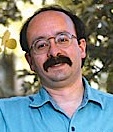
Amory Lovins
Hansen’s full argument for nuclear can be found on pages 194-204 of his 2009 book, Storms of My Grandchildren: The Truth About the Coming Climate Change Catastrophe and Our Last Chance to Save Humanity.
James Hansen
Climatologist James Hansen is much tougher on Lovins than I am. In his late-2009 book, Storms of my Grandchildren, Hansen wrote: “It is no wonder that Lovins is hugely popular on the rubber-chicken circuit. But it is dangerous to listen to a siren without checking real-world data.” (p 208) And: “Most energy experts believe that Lovins is overly, even wildly, optimistic.” (p 191)
A good survey of existing and planned nuclear desalination projects is here.
A December 2009 piece in the New York Times blog says that China is considering a nuclear commercial fleet of ships.
My term “microreactors” is used by no one but me, I notice, and it probably won’t be until there are desktop reactors. The emergent term for what I’m describing here is “SMRs”—small modular reactors.
UPDATE. Sweden also has selected a permanent nuclear waste repository, as of June 2009. It is located near Östhammar, adjoining a nuclear power plant.
UAE update: In December 2009 the UAE announced that it was ordering four 1.4 gigawatt reactors from a consortium of South Korean companies. The larger order from South Korea instead of France surprised the industry.
U.S. Secretary of Energy Stephen Chu wrote a piece strongly supportive of Small Modular Reactors in the March 23, 2010, Wall Street Journal.



